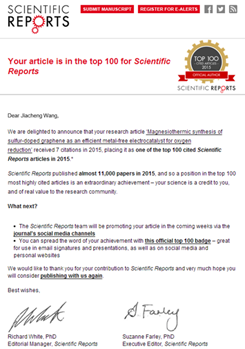Scientists Develop Heteroatom-doped Graphene towards Electrocatalytic Applications
Heteroatom doped graphene, such as nitrogen or sulfur doped graphene, possesses the adjustable electronic structures except for its intrinsic and superior properties resulting from graphene itself, making it highly potential in electrocatalytic applications. The doping of heteroatoms into graphene framework can adjust the charge density of the adjacent carbons atoms which thus have positive or negative charges and are advantageous for the adsorption of oxygen molecule or protons. Thus the heteroatom-doped graphene demonstrates the outstanding performance for electrocatalytic oxygen reduction or hydrogen evolution.
The research team led by Prof. Qian Liu and Jiacheng Wang developed the varied efficient synthesis procedures for heteroatoms-doped graphene materials, thus great progress having been made in N-, S-, or dual-doped (N,B; N,S; N,P) towards for electrocatalytic applications (Nano Research, 2016, 9(3), 808–819;Carbon, 2016, 102, 58-65;Scientific Report, 2015, 5, 9304).
Recently, the Tsinghua University Press recommended the Nano Research paper “Novel Synthesis of N-doped Graphene as an Efficient Electrocatalyst towards Oxygen Reduction (Nano Research, 2016, 9(3), 808–819) from Prof. Qian Liu and Jiacheng Wang as a research highlight to the webpage of “EurekAlert! Chinese Edition” hosted by AAAS. The link: http://chinese.eurekalert.org/zh/pubnews.php?start=25. The first author is Dr. Ruguang Ma, a young scientist from the team of Prof. Qian Liu and Jiacheng Wang. Prof. Dr. Jianjun Liu from the calculation center of SICCAS performed the theoretical calculations on the evolution of the N groups upon heating. Based on the experimental and theoretical results, it can be concluded that the increased content of the pyridinic groups can significantly improve the electrocatalytic oxygen reduction properties. This result provided the direct evidence and scientific interpretation for the controversy topic that “how the types of the doped N groups into carbon affect the electrocatalytic active sites”. Recently, a team in Japan also published a paper in Science (Guo et al, Active Sites of Nitrogen-doped Carbon Materials for Oxygen Reduction Reaction Clarified using Model Catalysts, Science, 2016, 351(6271), 361-365) to confirm the active sites of N-doped Carbon, and made the similar conclusions. The Japanese research team concluded that the pyridinic groups modified the Levis basicity of the adjacent carbon atoms, thus improving the oxygen reduction performance of the N-doped carbon materials.
Furthermore, a paper on sulfur-doped graphene from Prof. Qian Liu and Jiacheng Wang received high citation times, making it one of the top 100 cited Scientific Reports papers among total ~11000 papers published in Scientific Reports in 2015.
The above work is supported by the National Natural Science Foundation of China, and Shanghai Municipal Science and Technology.




